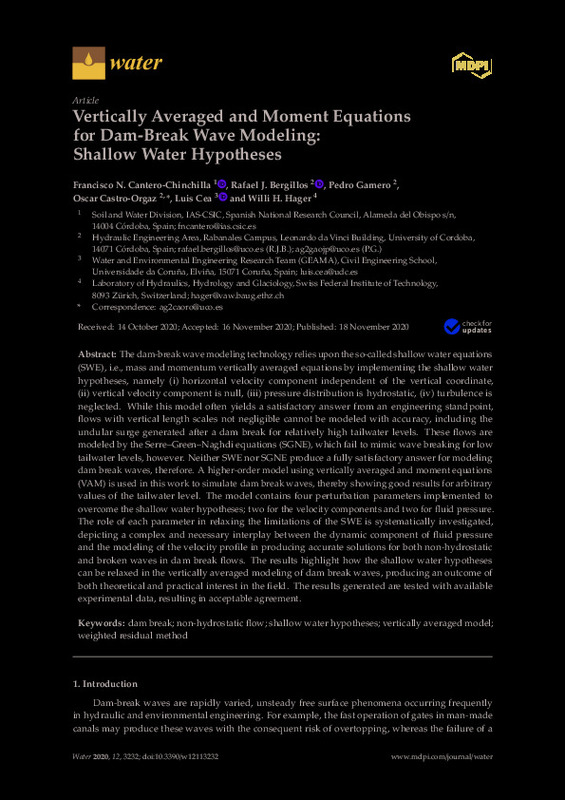JavaScript is disabled for your browser. Some features of this site may not work without it.
Buscar en RiuNet
Listar
Mi cuenta
Estadísticas
Ayuda RiuNet
Admin. UPV
Vertically Averaged and Moment Equations for Dam-Break Wave Modeling: Shallow Water Hypotheses
Mostrar el registro sencillo del ítem
Ficheros en el ítem
| dc.contributor.author | Cantero-Chinchilla, Francisco N.
|
es_ES |
| dc.contributor.author | Bergillos-Meca, Rafael Jesús
|
es_ES |
| dc.contributor.author | Gamero, Pedro
|
es_ES |
| dc.contributor.author | Castro-Orgaz, Oscar
|
es_ES |
| dc.contributor.author | Cea, Luis
|
es_ES |
| dc.contributor.author | Hager, Willi H.
|
es_ES |
| dc.date.accessioned | 2024-03-08T11:18:20Z | |
| dc.date.available | 2024-03-08T11:18:20Z | |
| dc.date.issued | 2020-11 | es_ES |
| dc.identifier.issn | 2073-4441 | es_ES |
| dc.identifier.uri | http://hdl.handle.net/10251/202992 | |
| dc.description.abstract | [EN] The dam-break wave modeling technology relies upon the so-called shallow water equations (SWE), i.e., mass and momentum vertically averaged equations by implementing the shallow water hypotheses, namely (i) horizontal velocity component independent of the vertical coordinate, (ii) vertical velocity component is null, (iii) pressure distribution is hydrostatic, (iv) turbulence is neglected. While this model often yields a satisfactory answer from an engineering standpoint, flows with vertical length scales not negligible cannot be modeled with accuracy, including the undular surge generated after a dam break for relatively high tailwater levels. These flows are modeled by the Serre-Green-Naghdi equations (SGNE), which fail to mimic wave breaking for low tailwater levels, however. Neither SWE nor SGNE produce a fully satisfactory answer for modeling dam break waves, therefore. A higher-order model using vertically averaged and moment equations (VAM) is used in this work to simulate dam break waves, thereby showing good results for arbitrary values of the tailwater level. The model contains four perturbation parameters implemented to overcome the shallow water hypotheses; two for the velocity components and two for fluid pressure. The role of each parameter in relaxing the limitations of the SWE is systematically investigated, depicting a complex and necessary interplay between the dynamic component of fluid pressure and the modeling of the velocity profile in producing accurate solutions for both non-hydrostatic and broken waves in dam break flows. The results highlight how the shallow water hypotheses can be relaxed in the vertically averaged modeling of dam break waves, producing an outcome of both theoretical and practical interest in the field. The results generated are tested with available experimental data, resulting in acceptable agreement. | es_ES |
| dc.description.sponsorship | This research was funded by the Spanish State Research Agency; project number CTM2017-85171-C2-1-R. FNCC and RB were partly funded by the Spanish Ministry of Science, Innovation and Universities through the research contracts FJCI-2016-28009 and FJCI-2017-31781, respectively. | es_ES |
| dc.language | Inglés | es_ES |
| dc.publisher | MDPI AG | es_ES |
| dc.relation.ispartof | Water | es_ES |
| dc.rights | Reconocimiento (by) | es_ES |
| dc.subject | Dam break | es_ES |
| dc.subject | Non-hydrostatic flow | es_ES |
| dc.subject | Shallow water hypotheses | es_ES |
| dc.subject | Vertically averaged model | es_ES |
| dc.subject | Weighted residual method | es_ES |
| dc.title | Vertically Averaged and Moment Equations for Dam-Break Wave Modeling: Shallow Water Hypotheses | es_ES |
| dc.type | Artículo | es_ES |
| dc.identifier.doi | 10.3390/w12113232 | es_ES |
| dc.relation.projectID | info:eu-repo/grantAgreement/AEI/Plan Estatal de Investigación Científica y Técnica y de Innovación 2013-2016/CTM2017-85171-C2-1-R/ES/DESARROLLO DE MODELOS NO HIDROSTATICOS PARA ESTUDIOS HIDROAMBIENTALES/ | es_ES |
| dc.relation.projectID | info:eu-repo/grantAgreement/MINECO//FJCI-2016-28009/ | es_ES |
| dc.relation.projectID | info:eu-repo/grantAgreement/MINECO//FJCI-2017-31781/ | es_ES |
| dc.rights.accessRights | Abierto | es_ES |
| dc.contributor.affiliation | Universitat Politècnica de València. Instituto Universitario de Ingeniería del Agua y del Medio Ambiente - Institut Universitari d'Enginyeria de l'Aigua i Medi Ambient | es_ES |
| dc.description.bibliographicCitation | Cantero-Chinchilla, FN.; Bergillos-Meca, RJ.; Gamero, P.; Castro-Orgaz, O.; Cea, L.; Hager, WH. (2020). Vertically Averaged and Moment Equations for Dam-Break Wave Modeling: Shallow Water Hypotheses. Water. 12(11). https://doi.org/10.3390/w12113232 | es_ES |
| dc.description.accrualMethod | S | es_ES |
| dc.relation.publisherversion | https://doi.org/10.3390/w12113232 | es_ES |
| dc.type.version | info:eu-repo/semantics/publishedVersion | es_ES |
| dc.description.volume | 12 | es_ES |
| dc.description.issue | 11 | es_ES |
| dc.relation.pasarela | S\483612 | es_ES |
| dc.contributor.funder | Agencia Estatal de Investigación | es_ES |
| dc.contributor.funder | Ministerio de Economía y Competitividad | es_ES |








